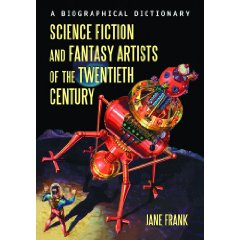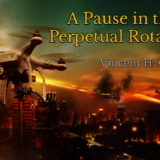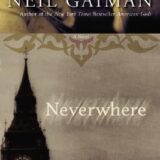
You may be wondering what inspired my ongoing series “Where are they Today?” – postings which shed light on the doings of artists whose works, only a short generation or so ago, were prime targets for collectors. Well, last year I stumbled upon a blog by the well-known mystery, romance, science fiction, and fantasy writer Kristine Kathryn Rusch and in seconds I was engrossed in her post on “Why Writers Disappear”
Rusch asked: How come writers vanished from bookstands? Why would a seemingly successful writer never write another book? Why did series end in the middle even when two more books were planned? ”Most readers – and most writers,” she said, “don’t know the answer.” But Rusch did. And the more I read, the more her explanations struck me as sounding eerily similar to the careers of artists I knew. For, what she called paths “fraught with potentials for career-destroying moments” for writers had their equivalents in the histories of SF/F book and magazine illustrators who also had “disappeared” (as far as fans and admirers of their work were concerned).
To paraphrase Rusch, and make the same point as she did, with regard to readers and writers, most art collectors don’t know why a seemingly successful cover artist would suddenly stop appearing on books, in the midst of a highly productive career. Or why an artist – known for work connecting them to a certain author, or book series – would create (let’s say) Volume 1 and 2 in a trilogy, then suddenly be replaced by another artist for Volume 3. Did they retire? Die? Become too ill to paint? Change careers mid-stream? These are the simple and understandable reasons. Others might really surprise you.
To borrow from Rusch’s definition, since she put it so well, when I say “disappear” I don’t mean that the artist has vanished off the face of the Earth. His family and friends still know where he is. And she may be participating in her local community and even continuing to be creative. But artists who disappear are artists who, for whatever reason, no longer produce new work –

from the perspective of readers and art collectors, who have come to recognize and look forward to seeing his or her contributions to the genre, and who have come to value her or his work for those and other reasons. Artists I have known well, and continue to keep in contact with, are primarily those who are still creating art . . . one way or another. Many more than I can spend entire posts writing about, however, have pretty much – seemingly dropped from sight – GONE. Rusch says “business” (the “business of writng”) is the main reason that writers disappear. Is this true for artists as well?
Yes. And the “business of art” can sometimes work in unusual ways. Let’s take one easy – but perhaps surprising (to you) – way that artists have “disappeared”
Can’t Get or Don’t Want New (or certain kinds of) Jobs
There’s a reason Rusch added the qualifier “new” to work being produced. As she writes “(B)efore the changes in the publishing world, writers often had to change their names to continue in the career. One pen name (or even the writer’s real name) would become an abandoned byline, and the writer would move to a new pen name. Sometimes the writer would take on a new pen name and a new genre.” This was just as true for commercial artists in the field of SF/F – although the list of artists affected this way was much shorter.

Some of you may remember Joseph Wirt Tillotson (Jan. 30, 1905 – Sept. 1, 1959), a prolific artist who published work under both his own name, Joe Tillotson, or Joe W. Tillotson, and “Robert Fuqua,” which he usually reserved for color work, in which category could be found many of his science fiction cover paintings. He was a staff artist for the Ziff-Davis chain of magazines when it was based in Chicago, Illinois. And, perhaps to enhance the appearance of diversity, or even-handedness in assignments, Tillotson occasionally was credited under both names in the same issue of a publication (e.g., Mammoth Adventure, May and Dec., 1947), which undoubtedly further helped preserve the fiction of two different artists.

Robert Weinberg (in his biographical dictionary, 1988) tells the anecdote that Tillotson and the science fiction writer, Earl Binder, were classmates at Boys High School in Chicago, and when they met some years later, that Tillotson remarked how much he enjoyed painting the cover for Binder’s story I Robot. Binder was surprised to learn that Tillotson and Fuqua were the same artist.
Tillotson was not the only master of the fictional nom de brush, nor did the practice die with the pulps. Hannes Bok (real name Wayne Woodard) may be the most famous example, but by the last quarter of the 20th century we also had “Sam Rakeland,” alter ego of artist Rick Berry, who painted in a traditional style quite unlike the “cyberpunk” Berry, and was able to garner assignments in the fantasy field that Berry disdained. And more recently, “Edward Miller,” who was invented by his evil twin Les Edwards, to get fantasy commissions that Edwards – then too well-known for his “splatter gore” horror illustrations – was denied.

Both Berry and Edwards used their pseudonymic entities to paint in styles that their fans would never have recognized, and possibly would have rejected had the works been credited to their “real” names when the images were first introduced. Drastic changes in what we call “signature styles” are not welcomed among collectors.
But then there is also Tom Kidd’s “Gnemo” – both a fictional person who signs for Kidd 🙂 and is the title of his book. Also hiding in plain sight are those artists who sign with their first or last names only, or versions of them: Boris (Boris Vallejo), Donato (Dan Giancola), Jill (Jill Bauman), Romas (Romas Kukalis), Rowena (Rowena Morrill), Gallardo (Gervasio Gallardo Villaseñor) – to name only a few. Edward Emshwiller did so much work in so many different styles that he used several names . . . there’s Emsh (the most popular, and the pseudonym most associated with him), and also Ed Emsler, Ed Alexander, Ed Emsch, EAE, Ensh, Harry Gars, and Willer.

Because few illustrative art collectors, just like readers, venture outside of their chosen genres, artists who kept their name but moved to another literary or art market – let alone worked under alternate names – virtually “disappeared” as far as the readers and collectors are concerned. This is not the same as saying “no work” at all – but it’s “no new work” in the way that’s meaningful to readers and collectors.
Gary Ruddell, for example, left the field of commercial illustration to become a successful gallery artist, producing work in a style totally unlike his book covers. Same for Morgan Weistling, Carl Lundgren, and others I could name. The same major changes in technique also often affects those who depart adult SF for the children’s market, to the extent that few collectors or readers would recognize their work, for example: James Warhola. Others kept their style, but moved to totally different markets, like Dean Morrissey. So, by and by, I will be shining my spotlight on these artists, too. Because how many SF/F art collectors have followed these artists to their new artistic careers? To readers of adult SF/F, or players of Role-Playing Games, these artists have just “disappeared.”











Good article, Jane. Thanks for that.